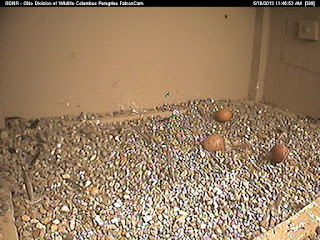Everything continues to go very well with the chick. It is growing fast! It is also advancing in its development such that it is becoming more mobile, preening, and vocalizing. It is mobile to the extent now, that it has strayed out of camera view a few times, causing mild panic in more than a couple of viewers. Therefore, I will use this blog post to attempt to give a better perspective of the layout of the nestbox and ledge to hopefully put some at ease.
Here is a photo of the nestbox from down the ledge a bit. In this picture you can see several things:
1) The "porch" directly in front of the nestbox. This porch is at the same level as the gravel so the chick can walk right out of the nestbox onto the porch. See also that the nestbox camera housing is mounted to the porch. As the chick wanders out of the box it will go out of view of the nestbox camera. Eventually, the chick will even leave the porch and wander down the lower level of the ledge towards the ledge camera. When it goes on this type of journey there will definitely be times when it will be out of view of both cameras.
2) This photo also shows the several inch vertical distance between the rear, lower level of the ledge and the front, upper level of the ledge where the adults land when they fly in. It will be another couple of weeks before the chick will be grown and strong enough to jump up to the upper part of the ledge.
Here is a close-up photo of the porch in front of the nestbox where again, it illustrates places the chick could go to where it would not be able to be viewed by the nestbox camera.
Even though the chick will wander, it will consider the nestbox its "home base" and return there if it feels threatened, to be fed (at least for now) and to sleep at night. The weather this weekend will be a bit cooler so I would suspect the chick may stay in the protection of the nestbox more the next couple of days. But then again, even with cool temps if the sun is shining strongly it will be quite warm on the ledge and the chick may not need to stay inside the box. Just some factors to consider.
Bottom line, please remember there will be times when the chick is NOT visible. Two cameras on the ledge are nice but they do not offer 100% view of all nooks and crannies of the box and ledge. Just because the chick and/or adults may not be visible does not automatically mean something is wrong. On the contrary, as I stated a few posts ago, remember that peregrines have been using this box and ledge setup quite successfully for the past 2 decades! It's always possible for something to go wrong, however, we (or should I say the peregrines?) have a pretty good track record at this site.
One other quick note: there is a Civil War reenactment going on this weekend on the statehouse lawn, which is directly across the street from the Rhodes Tower. Part of the activities include firing of cannons. These loud booms can be heard via the live streaming and sometimes they do momentarily alarm the adults. However, it isn't anything to be concerned about - to the falcons it's just part of living downtown and isn't much different from a loud clap of thunder (which we are also hearing today!). Enjoy and thanks for everyone's support and concerns!















